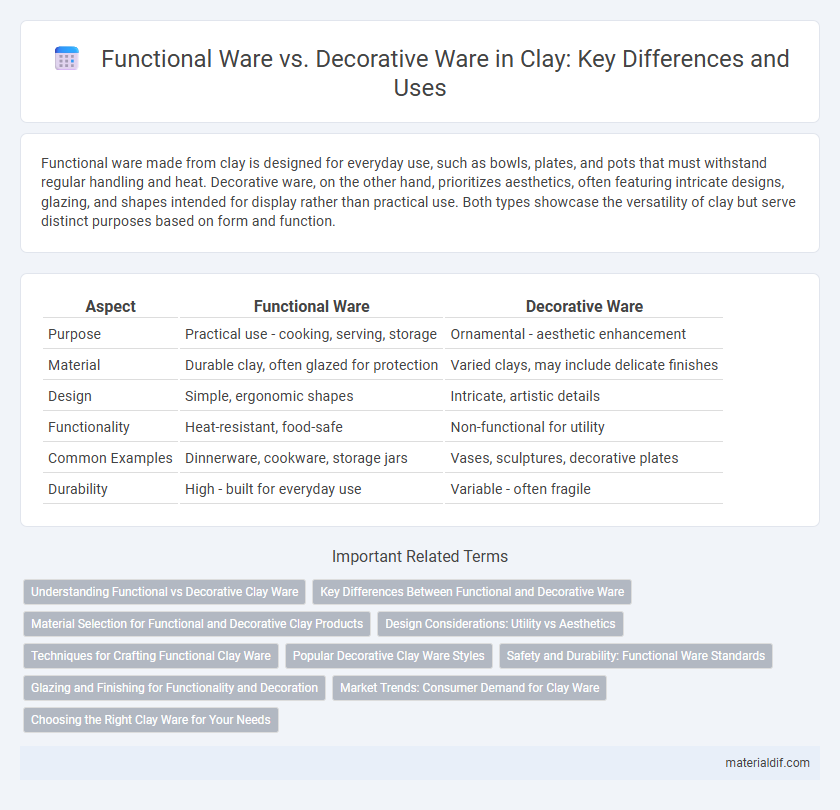Functional ware made from clay is designed for everyday use, such as bowls, plates, and pots that must withstand regular handling and heat. Decorative ware, on the other hand, prioritizes aesthetics, often featuring intricate designs, glazing, and shapes intended for display rather than practical use. Both types showcase the versatility of clay but serve distinct purposes based on form and function.
Table of Comparison
| Aspect | Functional Ware | Decorative Ware |
|---|---|---|
| Purpose | Practical use - cooking, serving, storage | Ornamental - aesthetic enhancement |
| Material | Durable clay, often glazed for protection | Varied clays, may include delicate finishes |
| Design | Simple, ergonomic shapes | Intricate, artistic details |
| Functionality | Heat-resistant, food-safe | Non-functional for utility |
| Common Examples | Dinnerware, cookware, storage jars | Vases, sculptures, decorative plates |
| Durability | High - built for everyday use | Variable - often fragile |
Understanding Functional vs Decorative Clay Ware
Functional clay ware serves practical purposes such as bowls, plates, and mugs designed for daily use, emphasizing durability, safety, and usability. Decorative clay ware, including sculptures, vases, and ornamental pieces, prioritizes aesthetic appeal and artistic expression over utility. Understanding the distinct firing temperatures, glazing techniques, and clay compositions helps differentiate functional ware optimized for longevity from decorative ware focused on visual impact.
Key Differences Between Functional and Decorative Ware
Functional ware is crafted primarily for practical use, such as bowls, plates, and mugs, emphasizing durability and usability in everyday tasks. Decorative ware focuses on aesthetic appeal, featuring intricate designs, vibrant glazes, and artistic forms intended for display rather than utility. Key differences include material composition optimized for strength in functional ware versus enhanced visual elements and fragility in decorative pieces.
Material Selection for Functional and Decorative Clay Products
Functional clay products require durable, non-porous materials such as stoneware or porcelain to withstand daily use and thermal shock. Decorative ware often utilizes softer, more porous clays like earthenware that allow for intricate detailing and vibrant glazing effects but are not suitable for heavy use. Selecting the appropriate clay body balances strength, firing temperature, and aesthetic qualities to ensure the intended function and appearance of the final piece.
Design Considerations: Utility vs Aesthetics
Functional ware prioritizes utility, emphasizing durability, ergonomic design, and ease of use for everyday tasks like cooking and serving. Decorative ware centers on aesthetics with intricate patterns, glazing techniques, and artistic forms meant to enhance visual appeal rather than practical function. Balancing these design considerations involves selecting materials and shapes that meet specific user needs while showcasing craftsmanship through surface decoration and finishing.
Techniques for Crafting Functional Clay Ware
Techniques for crafting functional clay ware prioritize durability and practicality, often involving wheel throwing, slab building, and coiling methods that create sturdy, balanced shapes suitable for daily use. Functional ware typically undergoes multiple firings, including bisque and glaze firing, to enhance strength, water resistance, and food safety. Glazing techniques focus on non-toxic, heat-resistant finishes that ensure both usability and aesthetic appeal in vessels such as mugs, plates, and bowls.
Popular Decorative Clay Ware Styles
Popular decorative clay ware styles include Majolica, known for its vibrant, tin-glazed surface; Raku, valued for its unpredictable textures and crackled finishes; and Sgraffito, featuring intricate carved or scratched designs revealing contrasting clay layers. These styles emphasize aesthetic appeal and artistic expression, often showcasing cultural heritage through color, texture, and pattern. Unlike functional ware, which prioritizes utility and durability, decorative clay pieces serve as visual art and collectible items.
Safety and Durability: Functional Ware Standards
Functional ware made from clay adheres to strict safety standards, including lead-free glazes and food-safe coatings, ensuring it is suitable for everyday use such as cooking and serving. Durability is enhanced through high-temperature firing processes that vitrify the clay, making functional pieces resistant to chipping, cracking, and thermal shock. These standards distinguish functional ware from decorative ware, which prioritizes aesthetic qualities over safety and practical resilience.
Glazing and Finishing for Functionality and Decoration
Functional ware emphasizes durable glazing techniques that create impermeable surfaces resistant to heat, moisture, and wear, ensuring practicality in everyday use. Decorative ware prioritizes aesthetic glazing, incorporating vibrant colors, intricate patterns, and varied textures to enhance visual appeal without necessarily focusing on durability. The finishing process for functional pieces typically involves smooth, uniform coatings for easy cleaning, while decorative items may feature textured or matte finishes that highlight artistic detail.
Market Trends: Consumer Demand for Clay Ware
Consumer demand for clay ware increasingly favors functional ware due to its practicality and sustainability, driving market growth in kitchenware, cookware, and tableware sectors. Decorative ware maintains niche appeal among collectors and interior designers, supported by trends valuing artisanal craftsmanship and unique aesthetics. Market analysis reveals a rising preference for multifunctional clay products that combine durability with artistic design, reflecting evolving consumer lifestyles and eco-conscious purchasing behaviors.
Choosing the Right Clay Ware for Your Needs
Functional clay ware emphasizes durability, non-toxicity, and heat resistance, making it ideal for everyday use such as cooking, serving, and storage. Decorative clay ware prioritizes intricate designs, glazing, and aesthetic appeal, often used for display or ceremonial purposes. Selecting the right clay ware depends on factors like intended use, exposure to heat or moisture, and desired visual impact, ensuring the chosen piece meets both practical and artistic requirements.
Functional Ware vs Decorative Ware Infographic

 materialdif.com
materialdif.com